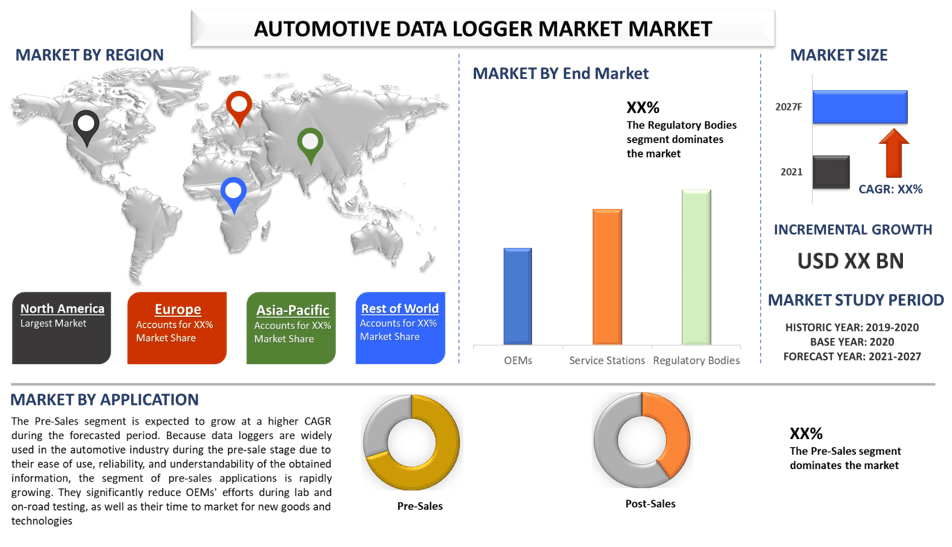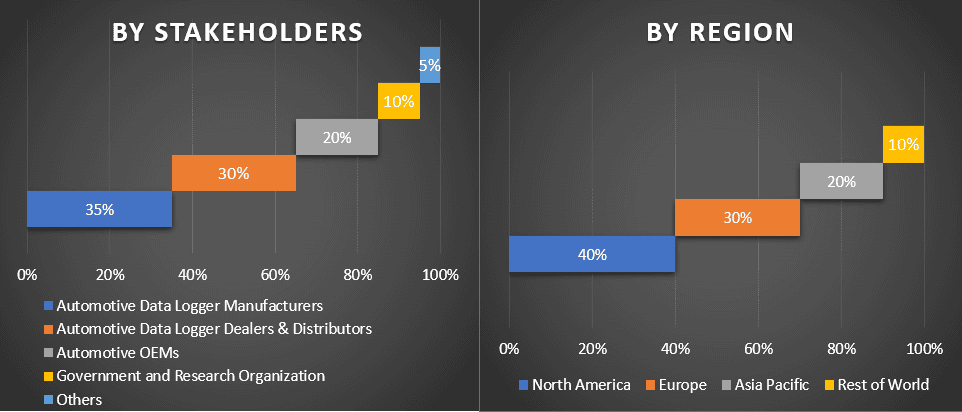- Startseite
- Über uns
- Industrie
- Dienstleistungen
- Lesen
- Kontaktieren Sie uns
Automotive Data Logger Markt: Aktuelle Analyse und Prognose (2021-2027)
Schwerpunkt auf Kanal (Controller Area Networking (CAN & CAN FD), Local Interconnect Network (LIN) und Flex Ray und Ethernet); Endmarkt (OEMs, Werkstätten und Aufsichtsbehörden); Anwendung (After-Sales und Pre-Sales); Verbindungstyp (SD-Karte, USB und Bluetooth/WIFI); Region und Land

KOSTENLOSE MUSTER-PDF ANFORDERN
Es wird erwartet, dass der globale Markt für Automotive Data Logger im Prognosezeitraum (2021-2027) eine CAGR von rund 7,5 % aufweisen wird. Moderne Autodatenlogger sind teurer als herkömmliche OBD-I-Systeme. Datenlogger, die lediglich CAN- und LIN-Kanäle unterstützen, sind jedoch kostengünstiger als solche, die alle wichtigen Kanäle (CAN, LIN, FlexRay und Ethernet) verarbeiten. Dies hängt auch von der Anzahl der analogen und digitalen Eingänge ab, die Datenlogger aufnehmen können. OEMs drängen die Datenlogger-Anbieter stets, die Gerätepreise zu senken und gleichzeitig die Gerätequalität zu erhalten. Da ihre Bemühungen zum Bau autonomer und vernetzter Fahrzeuge erheblich zugenommen haben, fordern OEMs zunehmend Datenrekorder an, die alle Kanäle abdecken. Da das Geschäft mit Automotive Data Loggern besonders preissensibel ist, ist der steigende Preis von Datenloggern in Schwellenländern ein Grund zur Besorgnis. Der Aufstieg der automobilen Netzwerk-Konnektivität setzt Fahrzeuge Gefahren aus. Selbst die grundlegendsten Aufgaben eines Autos sind heute auf Elektronik und Software angewiesen, mit 30 bis 40 Millionen Codezeilen in Low-End-Fahrzeugen und 100 Millionen Codezeilen in High-End-Fahrzeugen; und der CAN-Bus ist das Herzstück dieses Netzwerks. Dieses Busmodul wurde jedoch bei seinem ersten Erscheinen vor 30 Jahren nicht für die Gewährleistung der Cybersicherheit entwickelt. Infolgedessen können Hacker die Sicherheit des Fahrzeugs und seiner Insassen leicht gefährden, indem sie den CAN-Bus reverse-engineeren.
Im Bericht vorgestellte Erkenntnisse
"Unter den Kanälen dominierte das Segment Controller Area Networking (CAN & CAN FD) den Markt im Jahr 2020"
Basierend auf dem Kanal ist der Markt in Controller Area Networking (CAN & CAN FD), Local Interconnect Network (LIN) und Flex Ray and Ethernet unterteilt. Das Segment Controller Area Networking (CAN & CAN FD) erwirtschaftete im Jahr 2020 einen Umsatz von USD XX Milliarden und wird voraussichtlich im Prognosezeitraum mit einer CAGR von XX % wachsen. CAN & CAN FD ist ein Datenkommunikationsprotokoll, das häufig in elektronischen Mess- und Steuerungssystemen verwendet wird, um Sensordaten und Steuerungsinformationen über Zweidrahtverbindungen zu übertragen. Automobilhersteller können Daten übertragen und Verbindungen mit 1 Mbit/s mit einem hohen Maß an Datenintegrität über CAN und CAN FD ermöglichen. Infolgedessen wird prognostiziert, dass die Kategorie während des Vorhersagezeitraums ihre Dominanz beibehalten wird
"Unter den Endmärkten dominierte das Segment der Regulierungsbehörden den Markt im Jahr 2020"
Basierend auf dem Endmarkt ist der Markt in OEMs, Servicestationen und Regulierungsbehörden unterteilt. Das Segment der Regulierungsbehörden erwirtschaftete im Jahr 2020 einen Umsatz von USD XX Milliarden und wird voraussichtlich im Prognosezeitraum mit einer CAGR von XX % wachsen. Dies lässt sich darauf zurückführen, dass sich die Branche in Richtung selbstfahrender und umweltfreundlicher Fahrzeuge entwickelt. Infolgedessen müssen bestehende Vorschriften und Regeln überarbeitet und verschiedene neue Gesetze und Vorschriften erlassen werden. Hierfür benötigen die Aufsichtsbehörden ein umfassendes Verständnis der Funktionsweise dieser modernen Autos, was den Einsatz von Datenrekordern in ihren Testlabors erforderlich macht
"Unter den Anwendungen dominierte das Segment Pre-Sales den Markt im Jahr 2020."
Basierend auf der Anwendung ist der Markt in Post-Sales und Pre-Sales unterteilt. Das Pre-Sales-Segment erwirtschaftete im Jahr 2020 einen Umsatz von USD XX Milliarden und wird voraussichtlich im Prognosezeitraum mit einer CAGR von XX % wachsen. Da Datenlogger in der Automobilindustrie während der Pre-Sales-Phase aufgrund ihrer Benutzerfreundlichkeit, Zuverlässigkeit und Verständlichkeit der gewonnenen Informationen weit verbreitet sind, wächst das Segment der Pre-Sales-Anwendungen rasant. Sie reduzieren die Bemühungen der OEMs während der Labor- und Straßentests sowie die Markteinführungszeit für neue Produkte und Technologien erheblich
"Unter den Verbindungstypen dominierte das USB-Segment den Markt im Jahr 2020."
Basierend auf dem Verbindungstyp ist der Markt in SD-Karte, USB und Bluetooth/WIFI unterteilt. Das USB-Segment erwirtschaftete im Jahr 2020 einen Umsatz von USD XX Milliarden und wird voraussichtlich im Prognosezeitraum mit einer CAGR von XX % wachsen. Die USB-Schnittstelle dominiert den globalen Markt, da sie Daten schnell und einfach von Fahrzeugdatenloggern auf Lesegeräte wie Mobiltelefone, Laptops und Computer überträgt. Ebenso ist der Datenlogger der zuverlässigste und kostengünstigste Weg des Datenaustauschs
"Nordamerika stellt den größten Markt dar."
Während des Projektionszeitraums wird erwartet, dass Nordamerika im Jahr 2020 den größten Marktanteil haben wird. Die Region Nordamerika ist ein Vorreiter in zahlreichen Technologien, auch wenn sie teuer sind. Die Datenlogger-Technologie berücksichtigt eine breite Palette von Parametern bei der Bewertung der Leistung eines Fahrzeugs, wobei Daten zu zahlreichen Fahrzeugkennzahlen zu einem höheren Preis verkauft werden. Darüber hinaus erfordert die Bedienung solcher Geräte hochqualifizierte Mitarbeiter. Infolgedessen hat sich das Sammeln von Daten aus dem Datenlogger und die Schulung zur Weiterqualifizierung von Personal in der Technologie als teure Operation erwiesen, die den potenziellen Einsatz von Datenloggern in der Automobilindustrie einschränkt. In einigen Regionen Asien-Pazifik, Lateinamerika, dem Nahen Osten und Afrika behindern die hohen Kosten für Datenerfassungssysteme von Datenloggern in Automobilen die Marktexpansion. Menschen in Nordamerika reagieren jedoch schnell auf neue Technologien, die auf den Markt kommen, und werden manchmal als Early Adopters neuer Technologien bezeichnet. Der Automotive Data Logger befindet sich ebenfalls in einem frühen Stadium, und es wird prognostiziert, dass die Region im Vergleich zu anderen Regionen im Prognosezeitraum am stärksten wachsen wird. Einige der wichtigsten Akteure auf dem Markt sind Aptiv PLC, Delphi Technologies, Continental AG, CSS Electronics, Harman International, ABB Ltd, Influx Technology, IPETRONIK GmbH & Co. KG, Intrepid Control Systems, Inc. und Robert Bosch GmbH usw.
Gründe für den Kauf dieses Berichts:
- Die Studie umfasst eine Marktdimensionierungs- und Prognoseanalyse, die von authentifizierten wichtigen Branchenexperten validiert wurde
- Der Bericht bietet einen schnellen Überblick über die Gesamtleistung der Branche auf einen Blick
- Der Bericht umfasst eine eingehende Analyse prominenter Branchenkollegen mit einem primären Fokus auf wichtige Finanzdaten, Produktportfolio, Expansionsstrategien und aktuelle Entwicklungen
- Detaillierte Untersuchung von Treibern, Beschränkungen, wichtigen Trends und Chancen, die in der Branche vorherrschen
- Die Studie deckt den Markt umfassend über verschiedene Segmente hinweg ab
- Tiefgreifende regionale und länderbezogene Analyse der Branche
Anpassungsoptionen:
Der Global Automotive Data Logger kann weiter an die Anforderungen oder jedes andere Marktsegment angepasst werden. Darüber hinaus versteht UMI, dass Sie möglicherweise Ihre eigenen geschäftlichen Anforderungen haben. Nehmen Sie daher Kontakt mit uns auf, um einen Bericht zu erhalten, der Ihren Anforderungen vollständig entspricht.
Inhaltsverzeichnis
Forschungsmethodik für den Markt für Automotive Data Logger (2020-2027)
Regierungen auf der ganzen Welt konzentrieren sich darauf, den CO2-Fußabdruck ihrer Länder zu verringern. Darüber hinaus nutzen politische Entscheidungsträger Vorschriften, um eine Ladeinfrastruktur in der gesamten Region aufzubauen. Die Einführung von Elektrofahrzeugen gewinnt weltweit an Bedeutung. Hersteller von Automotive Data Loggern müssen mit diesem Nachfrageanstieg Schritt halten, um EV-Datenlogger zu entwickeln und zu bauen, die EV-Controller, Batterien, Bremssysteme, Batterieleistung, Beleuchtungssysteme, HVAC und Infotainment messen können. Der Automobilsektor hingegen möchte automatisierte Fahrzeuge testen, um das Reiseerlebnis zu verbessern und gleichzeitig die Sicherheit zu gewährleisten. Autonome Fahrzeuge verwenden eine Vielzahl von Sensortechnologien, um die Fahrzeugleistung zu verfolgen und zu analysieren, was attraktive Perspektiven für Anbieter auf dem weltweiten Markt für Automotive Data Logger bieten kann. Datenlogger für ADAS-Funktionen sind aufgrund der wachsenden Abhängigkeit von ADAS-Systemen für eine erhöhte Verkehrssicherheit stark nachgefragt. Die Prüfung und Validierung großer Datenmengen, die von Sensoren wie Ultraschall, Lidar, Laser, Radar und videobasierten Systemen erzeugt werden, stellt eine große Herausforderung bei ADAS-Tests dar. Mit Cloud-basierten Datenrekordern kann dieses Problem gelöst werden. In ADAS-Testsystemen werden sowohl Hardware- als auch Softwaretechniken eingesetzt. Software in the Loop (SIL), Hardware in the Loop (HIL) und Driver in the Loop (DIL) Tests können alle verwendet werden.
Weitere Details zur Forschungsmethodik anfordern
Die Automobilbranche befindet sich in einem enormen Wandel, mit vernetzten und autonomen Fahrzeugen am Horizont. Über ein Onboard-Netzwerk von Sensoren erzeugen diese Autos riesige Datenmengen. OEMs können Fahrzeugdaten nutzen, um neue Einnahmequellen zu erschließen und die Fähigkeiten vernetzter Fahrzeuge zu verbessern, wie z. B. nutzungsbasierte Versicherungen (UBI), Echtzeitanalysen, Datenmarktplätze/Monetarisierung und mehr. Die Nachfrage nach Datenloggern für Tests, Leistungsbewertung und Datenerfassung steigt aufgrund dieser neuen potenziellen Einnahmequellen und der wachsenden Popularität vernetzter Autos. Der weltweite Markt für Automotive Data Logger wird durch diese verschiedenen Anwendungen angetrieben. Automobilhersteller modifizieren ihre Fahrzeuge mit einem komplexen Netzwerk elektronischer Komponenten, die die Sicherheit und den Fahrkomfort verbessern, aufgrund der rasanten Veränderungen in der Regulierungslandschaft und den Kundenerwartungen. Die zunehmende Modernisierung von Automobilsystemen schafft ein günstiges Umfeld für die Datenloggerintegration. Infolgedessen treibt die sich ändernde elektrische Architektur von Fahrzeugen die globale Automotive Data Logger-Industrie an.
Analyse der historischen Marktgröße
Schritt 1: Eingehende Untersuchung sekundärer Quellen:
Es wurde eine detaillierte Sekundärstudie durchgeführt, um die historische Marktgröße des Automotive Data Loggers durch unternehmensinterne Quellen wie Jahresberichte und Finanzberichte, Leistungsvorträge, Pressemitteilungen usw. und externe Quellen wie Journale, Nachrichten und Artikel, Regierungsveröffentlichungen, Wettbewerbsveröffentlichungen, Sektorberichte, Datenbanken von Drittanbietern und andere glaubwürdige Veröffentlichungen zu erhalten.
Schritt 2: Marktsegmentierung:
Nachdem wir die historische Marktgröße des Automotive Data Loggers erhalten hatten, führten wir eine detaillierte Sekundäranalyse durch, um historische Markteinblicke und Anteile für verschiedene Segmente und Untersegmente für wichtige Regionen zu sammeln. Zu den wichtigsten Segmenten im Bericht gehören Kanal, Endmarkt, Anwendung, Verbindungstyp. Weiterhin wurden regionale und länderbezogene Analysen durchgeführt, um die allgemeine Akzeptanz des Automotive Data Loggers im globalen Kontext zu bewerten.
Schritt 3: Faktorenanalyse:
Nachdem wir die historische Marktgröße verschiedener Segmente und Untersegmente erfasst hatten, führten wir eine detaillierte Faktorenanalyse durch, um die aktuelle Marktgröße zu schätzen. Darüber hinaus führten wir eine Faktorenanalyse unter Verwendung abhängiger und unabhängiger Variablen wie wachsender staatlicher Anreize und der Nachfrage nach umweltfreundlichen Transportmitteln usw. durch. Historische Trends und ihre Auswirkungen von Jahr zu Jahr auf die Marktgröße und den Marktanteil wurden analysiert. Die Nachfrage und das angebotsseitige Szenario wurden ebenfalls gründlich untersucht.
Aktuelle Marktschätzung und Prognose
Aktuelle Marktgröße: Basierend auf verwertbaren Erkenntnissen aus den oben genannten 3 Schritten haben wir die aktuelle Marktgröße, die wichtigsten Akteure auf dem Markt und die Marktanteile der Segmente und des Unternehmens ermittelt. Alle erforderlichen prozentualen Aufteilungen und Marktaufschlüsselungen wurden unter Verwendung des oben genannten sekundären Ansatzes ermittelt und durch Primärinterviews verifiziert.
Schätzung & Prognose: Für die Marktschätzung und -prognose wurden verschiedenen Faktoren Gewichte zugewiesen, darunter Treiber & Trends, Einschränkungen und Chancen für die Stakeholder. Nach der Analyse dieser Faktoren wurden relevante Prognosetechniken, d. h. der Bottom-up-Ansatz, angewendet, um die Marktprognose bis 2027 für verschiedene Segmente und Untersegmente in den wichtigsten Regionen weltweit zu erstellen. Die Forschungsmethodik zur Schätzung der Marktgröße umfasst:
- Die Marktgröße der Branche in Bezug auf Wert (US$) und die Akzeptanzrate von Automotive Data Loggern in den wichtigsten Märkten
- Alle prozentualen Anteile, Aufteilungen und Aufschlüsselungen von Marktsegmenten und Untersegmenten
- Hauptakteure im Automotive Data Logger in Bezug auf die angebotenen Produkte. Auch die Wachstumsstrategien, die diese Akteure anwenden, um im schnell wachsenden Markt zu konkurrieren.
Validierung der Marktgröße und des Marktanteils
Primärforschung: Es wurden eingehende Interviews mit den wichtigsten Meinungsführern (Key Opinion Leaders, KOLs) geführt, darunter Führungskräfte der obersten Ebene (CXO/VPs, Vertriebsleiter, Marketingleiter, Betriebsleiter, Regionalleiter, Landesleiter usw.) in wichtigen Ländern. Die Ergebnisse der Primärforschung wurden dann zusammengefasst und eine statistische Analyse durchgeführt, um die aufgestellte Hypothese zu beweisen. Die Ergebnisse der Primärforschung wurden mit den Ergebnissen der Sekundärforschung zusammengeführt, wodurch Informationen in verwertbare Erkenntnisse umgewandelt wurden.
Aufteilung der primären Teilnehmer in verschiedenen Regionen

Markt Engineering
Die Datentriangulationstechnik wurde eingesetzt, um die Gesamtmarktschätzung abzuschließen und genaue statistische Zahlen für jedes Segment und Untersegment des Automotive Data Loggers zu erhalten. Die Daten wurden in mehrere Segmente und Untersegmente aufgeteilt, nachdem verschiedene Parameter und Trends in den Bereichen Höhensystem, Typ, Produkttyp, Struktur und Region untersucht worden waren.
Das Hauptziel der Automotive Data Logger Studie
Die aktuellen und zukünftigen Markttrends des Automotive Data Loggers wurden in der Studie ermittelt. Investoren können strategische Einblicke gewinnen, um ihre Entscheidungen für Investitionen auf der Grundlage der in der Studie durchgeführten qualitativen und quantitativen Analyse zu treffen. Aktuelle und zukünftige Markttrends würden die Gesamtattraktivität des Marktes auf regionaler und Länderebene bestimmen und den Industrieteilnehmern eine Plattform bieten, um den unerschlossenen Markt auszunutzen und als First-Mover-Vorteil zu profitieren. Weitere quantitative Ziele der Studien sind:
- Analyse der aktuellen und prognostizierten Marktgröße des Automotive Data Loggers in Bezug auf Wert (US$). Analysieren Sie auch die aktuelle und prognostizierte Marktgröße verschiedener Segmente und Untersegmente
- Segmente in der Studie Kanal, Endmarkt, Anwendung und Verbindungstyp
- Definierte Analyse des regulatorischen Rahmens für die globale Automotive Data Logger-Industrie
- Analysieren Sie die Wertschöpfungskette, die mit der Anwesenheit verschiedener Vermittler verbunden ist, und analysieren Sie das Kunden- und Wettbewerbsverhalten der Branche
- Analysieren Sie die aktuelle und prognostizierte Marktgröße des Automotive Data Loggers für die wichtigsten Regionen und Länder
- Zu den wichtigsten Regionen, die im Bericht untersucht werden, gehören Nordamerika (USA, Kanada, Rest von Nordamerika), Europa (Deutschland, Vereinigtes Königreich, Frankreich, Spanien und Rest von Europa), Asien-Pazifik (China, Japan, Indien, Südkorea, Rest von Asien-Pazifik) und Rest der Welt
- Unternehmensprofile der Automotive Data Logger-Akteure und die von ihnen angewandten Wachstumsstrategien, um sich in dem schnell wachsenden Markt zu behaupten
- Eingehende regionale und länderbezogene Analyse der Branche
Verwandt Berichte
Kunden, die diesen Artikel gekauft haben, kauften auch










